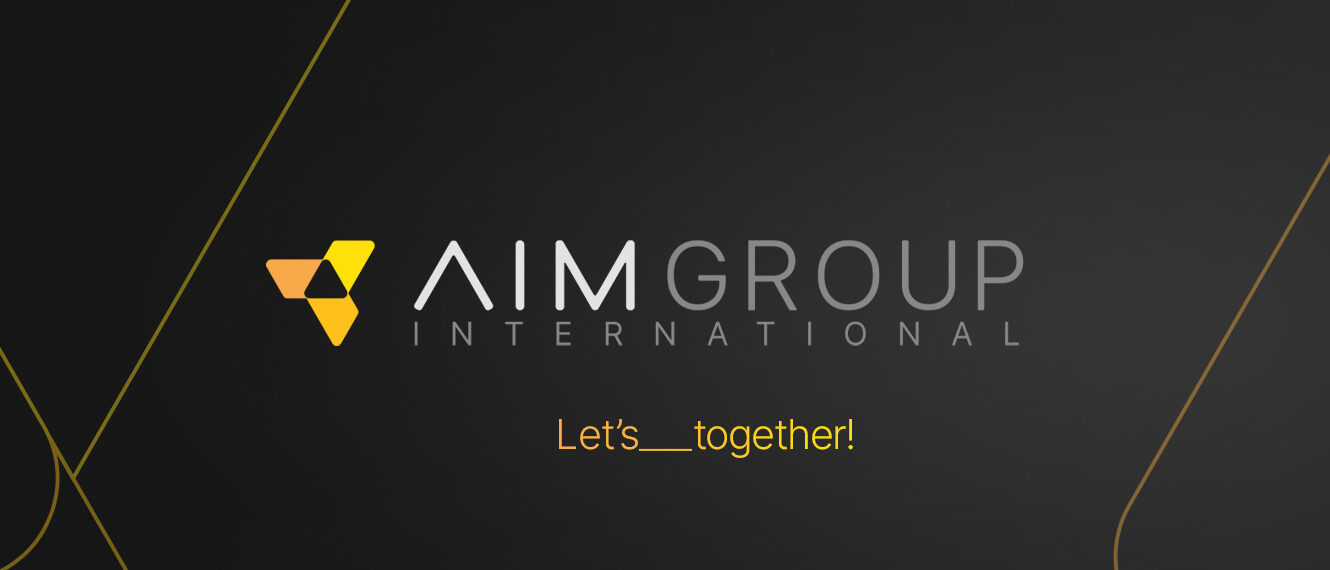
AIM Group Rebranding: what’s behind the scenes
How do you build a rebranding project? Which corporate functions are involved? How best to balance loyalty to the brand’s values and history with the need for renewal? How best to roll out the new identity across all channels and materials? Giuseppe Mayer, general manager of AIM Communication, talks about the methods and processes that structured the recent rebranding of AIM Group
AIM Group International recently presented a comprehensive new brand identity which included a new logo, a new website and a new coordinated image for all communication materials. The new brand identity was conceived and curated entirely by AIM Communication, the group’s communication hub, and is the result of a long, in-depth and collaborative process.
Brands, like people and organizations, continuously evolve – in relation to market context, technological changes and clients’ needs and objectives. And this has been particularly true for AIM Group and the communication and events market as a whole over the last few years.
Promoting a corporate rebrand is a complex and important operation. Many variables must be carefully evaluated, and different points of view and consequences considered.
Depending upon the underlying strategic goals, the relaunch of brand’s identity may involve the renewal of one or more elements such as the name, logo, and communication materials. The changes may be predominantly visual, or alternatively may represent an evolution or even a clear break with the past.
How do you identify the key elements you want to change, the values and messages you wish to to convey and the new communication assets that you will consequently develop?
Here are the main stages of the rebranding process:
- Assessment
“The value of an organisation with a long history such as AIM Group’s lies primarily in the people who work there and its community of clients. We therefore started by involving these two groups in auditing and active listening activities, with a view to identifying the brand’s perceived strengths and weaknesses, the way it is characterised and the brand message. We complemented this analysis with a competitive assessment of the market performance of our digital communication assets ” explains Giuseppe Mayer, general manager of AIM Communication.
- Brand Identity Framework
We used specific interpretative schemes to analyse the information we gathered and to understand which of the positive elements we should build upon and in which direction we should build the new brand concept. “Identifying the brand essence is essential to understand how best to differentiate the brand from its commercial competitors in a clear, recognizable and sustainable way. Later, we moved on to the development of the core identity, which incorporates the most important underlying elements, and of the extended identity, – that is to saythe various articulations of the brand’s personality that can help describe it as if it were a person, with precise characteristics perceived from outside” continues Mayer.
Let’s introduce you AIM Group.
So, in the light of all these analyses, which adjectives would we use to describe AIM Group if it were a person?
“The key adjectives that we identified are: Open, Respected, Solid, International, Multi-talented, Agile / Adaptive, Visionary, Passionate, Partner. And at the heart of the core identity there is a fundamental characteristic: Adaptive Business Vision”.
“From this new Framework we developed the new brand narrative. This is represented by a triangle – a symbol of strength, security and dynamism that conveys our key message. “We Ignite meaningful connections” expresses the essence of our mission and ability: we create meaningful connections between brands and people through the experiences, solutions and ideas we develop within our three areas of specialization – Events, Consultancy and Communication” adds Mayer.
This concise and focused outcome is essential to the development of a new brand identity, because it allows you to communicate the value proposition to the market in a simple and direct way. To be even more incisive, a payoff can also be developed – a short sentence that completes and clarifies the identity of the brand.
Let’s__together is AIM Group’s payoff. “It incorporates the key elements of the group’s approach. Togetherness – the desire to act collaboratively with clients, as transparent and trusted partners. Proactivity and positive spirit and a willingness to start something new. The multiple activities that we can do together, filling the empty space between Let’s and together. Let’s meet, let’s engage, let’s think, express the main areas – events, communication and consultancy – but the phrase is enormously flexible and can be applied to many areas – for example, let’s work, let’s imagine, let’s plan, let’s brainstorm, etc.
- Development of new key assets
From strategic thinking we then move on to the action plan. How do elements such as the tagline, the key message and the brand personality concretely influence the communication materials we develop? Here the creative department comes into play, interpreting the set of values, messages and qualities within a new logo design, new institutional communication materials (corporate brochure, website, videos, ppt presentations), new marketing & sales tools and all the other collateral elements (letterhead, business cards, envelopes and stickers, etc.) that are consistent with the new identity.
As we have seen, “redesigning the brand identity is a long journey, offering a useful opportunity to reflect upon the company: its vision, its mission, its value proposition and personality, and the way it does business. In fact, one of the most important challenges is to embody the new brand identity in our day-to-day business practice. This is why involving, informing and educating company colleagues at all levels is essential to the success of this important operation. Is it worth it? Absolutely! The value of a company typically grows as a result of rebranding; its reputation is enriched, and innovation is triggered both within the company and in its external relations with the market. These are all important elements to promote the development and success of a brand over time” concludes Mayer.

